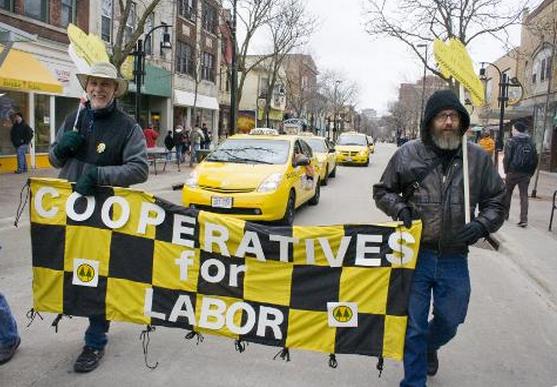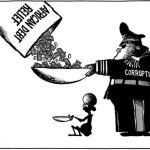[captionpix imgsrc=”https://pvnn.org/wp-content/uploads/2015/08/greg1.jpg” captiontext=”Photo courtesy of community-wealth.org”]
The late 1970s ushered in a new, post-industrial economic development model for America’s urban centers—known widely as the “neoliberal” paradigm—founded upon export-base competition among our cities. Export-base theory “dominates the thinking about local economic development in the United States. Its underlying premise—the external demand for a region’s products as primary determinant of regional prosperity—is widely accepted.”[ref]Casper-Futterman, Evan. “Back to (Non)Basics: Worker Cooperatives as Economic Development.” Berkeley Planning Journal: 24(1). 2011.[/ref] Certain cities, like New York, San Francisco and Los Angeles, have had successful transitions from the manufacturing-heavy economy of the 19th and 20th centuries to our present day knowledge-based economy, while others like Detroit, Cleveland and Newark, NJ, have struggled. This has not stopped cities in the latter category from attempting to entice investors, sports franchises and corporate headquarters, but the resulting development, more often than not, ignores the wants and needs of actual residents. In Newark, for instance, despite reports of a city-wide development boom over the past several years, residents tend to feel the benefits of that development are going to “outsiders.”[ref]Newark, New Jersey 2012-2013 Community Needs Assessment. The Center for Collaborative Change. 2013.S[/ref]
There exists, therefore, a deep vendetta between the interests of many city officials, who need the tax revenue gained through corporate taxes and desire the resulting prestige and competitive edge, and those of city residents, who look to their local government for the provision of many services. Unfortunately, state and federal aid to our urban centers has all but dried up over the past few decades, and their municipal coffers are taking a hit. Cities are thus forced to compete for investment from private entities, but actual city residents are the ones actually paying the price. Subsidizing the migration of a corporate headquarters continually takes precedent over the delivery of much needed public services to residents of struggling inner cities.
One of the most innovative new approaches to economic development—begun in Mondragon, Spain, adopted in Cleveland, Ohio, and now known in the U.S. as the Cleveland Model—is the democratic economic growth and wealth-building strategy of worker cooperatives. “From the network of small and medium cooperative businesses that already exist in the United States, there is sufficient evidence to indicate that by offering living wages and wealth-building opportunities (in the form of workplace equity) in traditionally low-wage service industries such as home repair, nursing care, local grocery stores, and cleaning services, worker cooperatives can assist in the stabilization and prosperity of marginalized communities.[ref]Casper-Futterman 2011.[/ref] The Cleveland Model requires initial investment by nonprofit and other private entities, in addition to a network of local connections with anchor institutions (in Cleveland’s case, a cluster of universities and hospitals), but over time they become not only self-sustaining, but an astounding wealth-building tool for the community. When the workers of a business are simultaneously the owners, they are the recipients of the dividends rather than external shareholders.[ref]Ibid.[/ref] And in Cleveland, the Cleveland Community Foundation (CCF) estimates that once a business has been operating for about a decade, an employee-owner will have built about $60,000 in equity, “in an area where median income is just under $20,000.”[ref]Ibid[/ref]
[captionpix imgsrc=”https://pvnn.org/wp-content/uploads/2015/08/gregpic1.jpg” captiontext=”Photo courtesy of community-wealth.org”]
There are, of course, challenges to the Cleveland Model. Certain fluid social dynamics are of paramount importance, and as one worker-owner at the Evergreen Cooperative Laundry in Cleveland admits, “If you’re not interested in giving it everything you have, then this isn’t the place you should be.”[ref]Ibid[/ref] A deep community desire for stable employment, therefore, is a necessity. Additionally, the pace of neighborhood revitalization that results from the Cleveland Model is not as quick as the rapid economic growth seen when corporate investors decide to single-handedly transform a city block. Again, though, the gradual growth of community wealth that characterizes the worker co-op model is utterly lacking in the neoliberal model—what is appropriate for one city may not work in another, even one of the same size if socio-economic conditions are different.
Neoliberal thinking has characterized urban economic development since the late 1970s as a way to ameliorate the devastating state and federal disinvestment that occurred after massive migrations to the suburbs. Now that our urban centers are experiencing unprecedented in-migrations, however, they require more than ever the type of investment on infrastructure and human capital that characterized the New Deal, WWII, and LBJ’s Great Society. Unfortunately, considering the congressional gridlock currently characterizing our politics, such a massive program is unlikely for the time being. In the meanwhile, then, worker cooperative offer an innovative, egalitarian form of economic development for marginalized communities, urban, inner-ring suburban and rural alike.
Take Action:
Community wealth-building is a lacking dimension in the most prevalent forms of modern economic development. While ushering in large private entities can provide local urban residents with numerous low-wage, service sector jobs, the wealth-building element of worker cooperatives is invaluable. Contribute to the mission here, with a tax-deductible donation.




